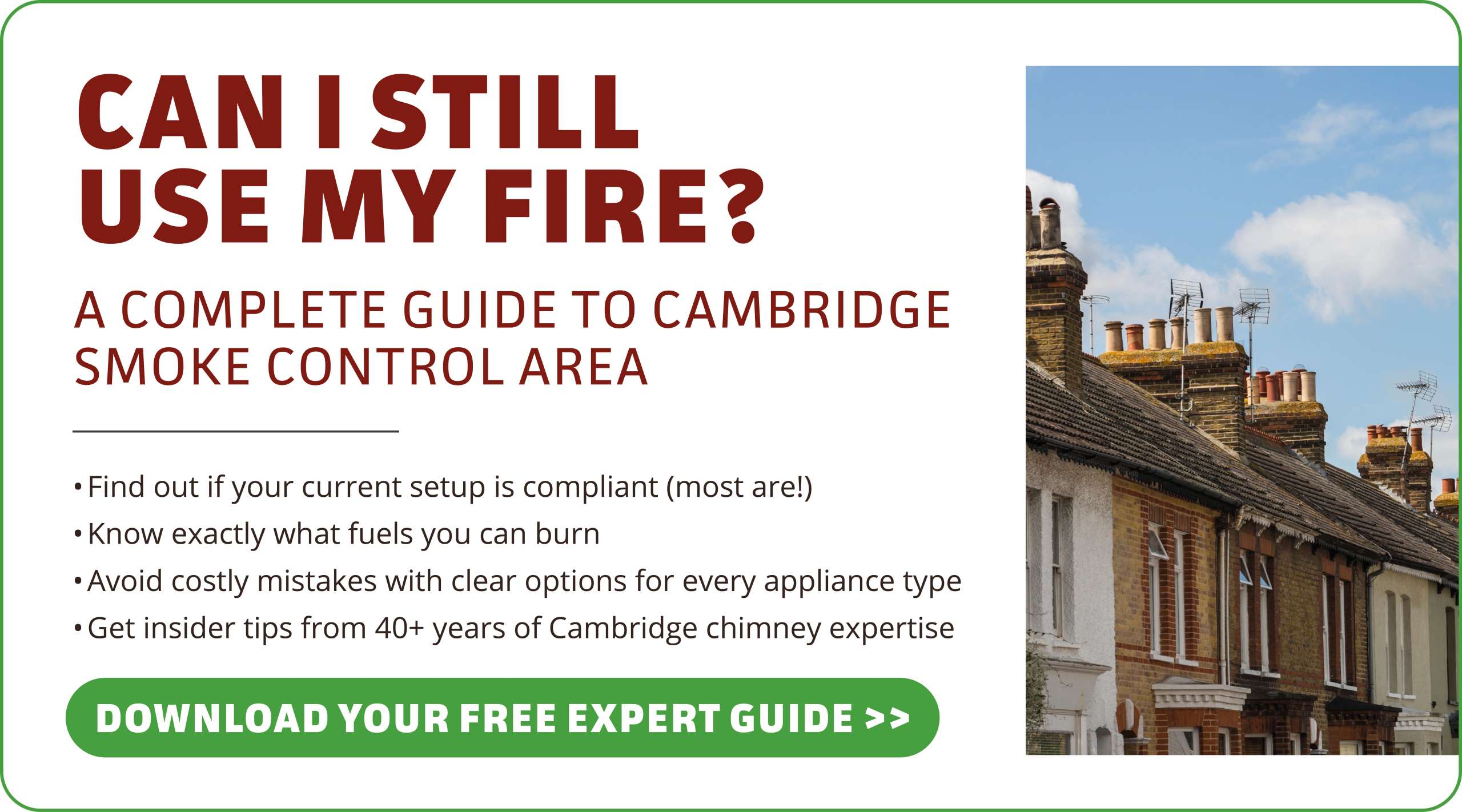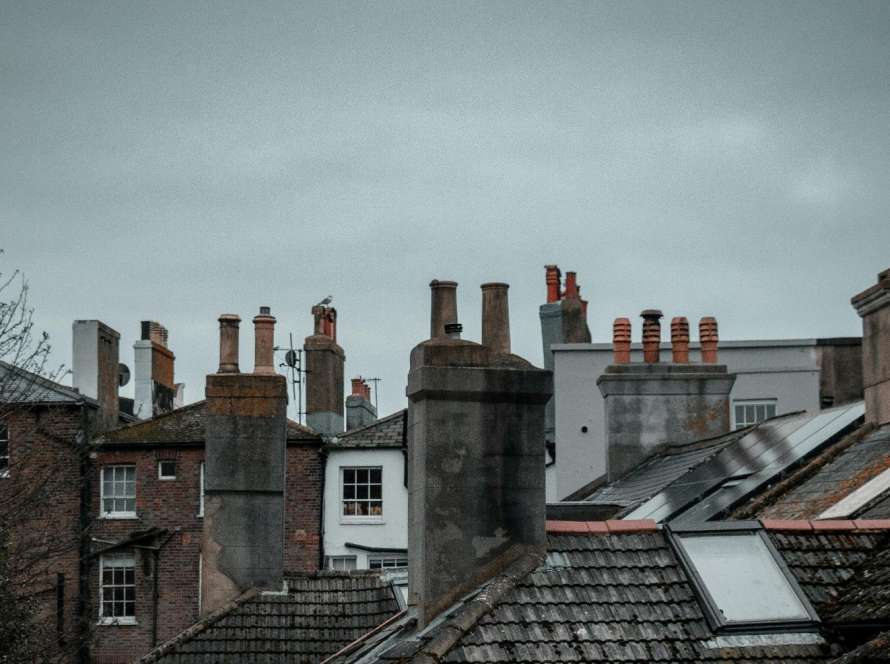If you’ve discovered that your stove is not DEFRA-approved, you’re not alone. Many Cambridge residents have non-DEFRA stoves, and while your options are more limited than DEFRA-approved stove owners, you still have several viable paths to stay compliant with Cambridge’s new city-wide Smoke Control Area starting January 2026.
Not sure if your stove is DEFRA-approved? Check our guide on How to Tell If Your Stove Is DEFRA Approved to identify your stove’s status before exploring your compliance options.
Understanding your Cambridge non-DEFRA stove options is crucial for choosing the right compliance path for your situation and budget. As Cambridge chimney sweeps with over 40 years of experience, we’ve helped hundreds of residents navigate these exact scenarios across all Cambridge areas including Abbey, Arbury, Castle, Cherry Hinton, Coleridge, East Chesterton, King’s Hedges, Market, Newnham, Petersfield, Queen Edith’s, Romsey, Trumpington, and West Chesterton.
Your compliance path depends primarily on whether you have a multi-fuel stove or a wood-burning-only stove, as these have very different capabilities and options.
Multi-Fuel vs Wood Burning Stove Cambridge: Understanding Your Stove Type
Before exploring your options, you need to identify what type of non-DEFRA stove you have, as this determines which compliance paths are available to you.
Multi-Fuel Stoves (With Ash Pan)
How to Identify:
- Has an ash pan or drawer that pulls out from underneath
- Features a riddle grate (metal bars) above the ash pan
- Ash falls through the grate into the removable pan
- Can typically burn both wood and coal-based fuels
Why This Design Matters: Multi-fuel stoves are designed to handle different types of fuel, including coal and smokeless fuels. The riddle grate allows ash to fall through, and the airflow system underneath supports coal combustion.
Wood-Burning Stoves (No Ash Pan)
How to Identify:
- No ash pan or drawer underneath
- Solid base where ash sits directly
- No riddle grate system
- Designed specifically for wood burning only
Why This Design Matters: Wood-burning stoves have solid bases optimised for wood combustion. They cannot effectively burn coal or most smokeless fuels because their design doesn’t handle the different ash characteristics and airflow requirements of these fuels.
This distinction is crucial because it determines which compliance options are practically available to you in Cambridge’s Smoke Control Area.
What Are My Options with Non-DEFRA Multi-Fuel Stoves?
If you have a non-DEFRA multi-fuel stove, you have several practical compliance options that don’t require major expenditure.
Option 1: Switch to Approved Smokeless Fuels
Best for: Multi-fuel stoves in good condition where wood burning isn’t essential
What This Involves:
- Stop burning wood entirely
- Use only approved smokeless fuels
- No modification to your existing stove required
- Immediate compliance once implemented
Approved Smokeless Fuels You Can Use:
- Anthracite coal (naturally smokeless, long burning)
- Semi-anthracite coal (good heat output, more affordable)
- Manufactured solid fuels marked “Authorised for use in smoke control areas”
Advantages:
- No capital expenditure required
- Immediate compliance
- Smokeless fuels often burn longer than wood
- Consistent heat output
- Available year-round regardless of weather
Considerations:
- Different burning characteristics from wood
- Need to learn new lighting and operating techniques
- Less traditional “wood fire” ambiance
Cambridge Fuel Supplier: Logs Direct delivers approved smokeless fuels throughout Cambridge and nationally with compliance guarantees.
Option 2: Non-DEFRA Stove Conversion Kits Cambridge
Best for: Multi-fuel stoves where manufacturer conversion kits are available
What Conversion Kits Do:
- Modify air intake systems for cleaner wood combustion
- Add secondary combustion components
- Improve burn efficiency to reduce emissions
- May allow continued wood burning (if successful)
Important Limitations:
- Only available for specific stove models
- Must be manufacturer-approved kits
- Installation doesn’t guarantee full DEFRA exemption status
- Always verify final compliance with manufacturer
- Not available for most older or import stoves
How to Check Availability: Contact your stove manufacturer directly with:
- Exact model number and year
- Photos of any identification plates
- Questions about conversion kit availability
- Confirmation of final compliance status
Installation: Most conversion kits can be installed by homeowners following manufacturer instructions.
Option 3: Replace with DEFRA-Approved Stove
Best for: Multi-fuel stoves where wood burning flexibility is important
Advantages:
- Full compliance with maximum fuel flexibility
- Can burn both seasoned wood and smokeless fuels
- Modern efficiency and cleaner burning
- Meets current standards and regulations
Considerations:
- Significant upfront investment
- Installation disruption
- Need to plan timing around heating season
What Are My Options with a Non-DEFRA Approved Wood-Burning Stove?
Wood-burning stoves without DEFRA approval have more limited options due to their design constraints.
Can I Use Smokeless Fuel in Non-DEFRA Wood Burning Stove?
The short answer is no. Non-DEFRA wood-burning stoves cannot effectively burn smokeless fuels because:
Design Issues:
- Solid base cannot handle coal ash characteristics
- Airflow system not designed for coal combustion
- No grate system to support coal burning
- Air controls optimised for wood, not coal
Practical Problems:
- Poor combustion efficiency with coal
- Potential damage to stove components
- Safety concerns from improper burning
- Likely compliance issues from poor combustion
Your Viable Options for Wood-Burning Stoves
Option 1: Check for Manufacturer Conversion Kits
- Contact manufacturer about conversion possibilities
- Some wood stoves can be modified for DEFRA compliance
- May allow continued wood burning after conversion
- Success varies significantly by model and age
Option 2: Replace with DEFRA-Approved Stove
- Regain wood burning capability legally
- Modern efficiency and performance
- Full compliance with maximum flexibility
Option 3: Converting Non-DEFRA Stove to Open Fireplace
- Remove stove and flue liner completely
- Restore original fireplace opening
- Use approved smokeless fuels only in open fireplace (no wood burning permitted)
- Professional work required for safe removal and restoration
- Maintains ability to have fires but with smokeless fuels only
Option 4: Stop Using the Stove
- Simply stop burning any fuel in the stove
- No work or modifications required
- Optionally remove stove and seal fireplace if desired
- Consider future heating needs
- Potential impact on property value
Cambridge Non-DEFRA Stove Compliance Timeline
Understanding Cambridge’s approach to enforcement helps you plan your compliance strategy.
Implementation Timeline
Current Status: Approved by Cambridge City Council, implementation process underway
Expected Start Date: January 2026
Your Action Window: Approximately 2-3 months to complete any changes needed
Enforcement Approach
Education-First Policy:
- Initial focus on helping residents understand requirements
- Guidance provided on compliance options
- Support for residents facing genuine difficulties
- Practical advice on fuel choices and burning techniques
Compliance Indicators:
- Visible smoke from chimneys is primary concern
- Complaints from neighbors about smoke issues
- Persistent smoke during appropriate weather conditions
- Response to guidance and advice from council
Preparing for Compliance
Immediate Steps:
- Identify your stove type (multi-fuel vs wood-burning)
- Research your specific compliance options
- Contact manufacturer about conversion kit availability (if applicable)
- Begin sourcing approved smokeless fuels for testing
Planning Considerations:
- Budget for fuel costs or stove modifications/replacement
- Schedule any work for completion before January 2026
- Test smokeless fuels to learn burning techniques
Frequently Asked Questions
I have a non-DEFRA stove but don’t know if it’s multi-fuel or wood-burning. How can I tell?
Look at the bottom of your stove. If there’s a removable ash pan or drawer and you can see metal grate bars above it, it’s multi-fuel. If the base is solid with no removable parts, it’s wood-burning only.
Can I continue using my non-DEFRA wood-burning stove with smokeless fuels?
No. Wood-burning stoves are designed specifically for wood and cannot effectively or safely burn smokeless fuels. Your options are conversion (if available), replacement, or alternative heating.
How do I know if conversion kits are available for my stove?
Contact your stove manufacturer with your model number and photos of identification plates. They can confirm availability and provide guidance on installation and final compliance.
What happens if I just continue burning wood in my non-DEFRA stove?
This would be non-compliant with Cambridge’s Smoke Control Area regulations. The council’s approach focuses on education first, working with residents to understand requirements and find practical solutions.
Are conversion kits guaranteed to make my stove DEFRA compliant?
No. Conversion kits may improve emissions, but don’t automatically provide DEFRA exemption status. Always verify final compliance with the manufacturer and keep documentation.
Can I burn a mixture of wood and smokeless fuels in my multi-fuel stove?
While multi-fuel stoves can handle both fuel types, it’s better to use one type at a time for optimal performance. Different fuels have different burning characteristics and air requirements.
Having a non-DEFRA stove doesn’t mean you can’t continue enjoying fires in Cambridge’s new Smoke Control Area. The key is choosing the right compliance path for your specific stove type and heating needs. Whether that’s switching to smokeless fuels, installing a conversion kit, or planning a replacement, there are viable options to keep you warm and compliant.
Expert Chimney Services for Clean, Compliant Burning
Getting the most from your chimney while meeting UK emission standards requires professional expertise. As authors of the City & Guilds Chimney Sweeping Qualification and certified Guild of Master Chimney Sweeps, Ablewight Chimney Services combines industry-leading knowledge with practical experience.
Our comprehensive chimney services ensure optimal performance, legal compliance, and safety:
- Professional chimney sweeping – Annual cleaning and maintenance
- CCTV chimney surveys – Advanced inspection technology
- Stove servicing – Complete maintenance and performance optimisation
- Bird nest removal – Wildlife-compliant clearance
- Bee nest removal – Safe clearance
- Tar and creosote removal – Specialist cleaning for heavy deposits
- Compliance certification – Insurance-valid documentation
- Expert advice – Personalised solutions for your heating system
Why Choose Ablewight:
- HETAS Approved for professional standards
- Trading Standards Approved for consumer protection
- Guild of Master Chimney Sweeps certified
- £5 million public liability insurance
- No-mess guarantee on all work
Get Professional Chimney Care Today:
- 01223 627012
- hello@ablewight.co.uk
Service Areas: Cambridge • Ely • Newmarket • Royston • Saffron Walden • St Ives • Huntingdon • St Neots • Bishop’s Stortford • All surrounding villages within 25 miles
Don’t compromise on safety, performance, or compliance. Contact Ablewight Chimney Services today for professional expertise you can trust.



